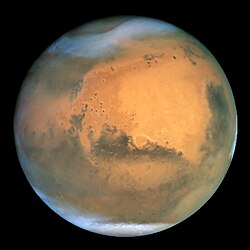HiRISE


High Resolution Imaging Science Experiment, většinou zkracována jako HiRISE, je polychromatická kamera pracující ve viditelné oblasti světelného spektra s vysokým rozlišením dosahující 30 až 60 cm/pixel, která se nachází na palubě americké planetární sondy Mars Reconnaissance Orbiter kroužící kolem planety Mars. Kamera váží 65 kilogramů a za cenu 40 miliónů amerických dolarů jí sestavila společnost Ball Aerospace & Technologies Corp. pod vedením Lunar and Planetary Laboratory University of Arizona. Její hlavní reflekční zrcadlo má průměr 0,5 metru, jedná se o největší zrcadlo umístěné zatím na misi do hlubokého vesmíru. Velikost zrcadla umožňuje pořizovat snímky objektů, které jsou přes 30 centimetrů velké.
K roku 2010 nasnímala kamera HiRISE okolo 1 % marsovského povrchu s tímto rozlišením.[1] Počátkem roku 2016 bylo pomocí HiRiSE zmapováno celkem 2,4 % povrchu Marsu.[2]
Koncem roku 2017 a počátkem roku 2018 byly snímky pořízené HiRISE rozmazané, v té době se Mars vyskytoval nejdále od slunce. Až 70 % snímků v plném rozlišení bylo rozmazaných. Poté, co se Mars opět přiblížil ke slunci, procento rozmazaných snímků kleslo téměř k nule. To naznačilo, že potíže byly způsobeny tepelným efektem. Snímací zařízení HiRISE je vybaveno aktivním termoregulačním systémem (TCS), který udržuje optickou část dalekohledu při teplotě přibližně 20 °C. Původní řídící software jednotku TCS vypínal během snímání vědeckých snímků na několik vteřin, což nemělo ovlivnit optickou jednotku. HiRISE se v té době potýkala s chybami některých kanálů AD převodníků, což způsobovalo nežádoucí artefakty na snímcích. Snaha o řešení tohoto problému vedla k deaktivaci TCS na delší dobu. Optická část se pak před snímkováním Marsu nestihla včas ohřát na 20 °C. Chybu způsobující rozmazání snímků se podařilo vyřešit sepnutím TCS i během pořizování snímků.[3]
Odkazy
Reference
V tomto článku byl použit překlad textu z článku HiRISE na anglické Wikipedii.
- ↑ Microsoft and NASA Bring Mars Down to Earth Through the WorldWide Telescope (07.12.10) – NASA. www.nasa.gov [online]. [cit. 2011-06-06]. Dostupné v archivu pořízeném z originálu dne 2017-06-22.
- ↑ STOLTE, Daniel. HiRISE: 45,000 Mars Orbits and Counting [online]. arizona.edu, 2016-03-16 [cit. 2022-02-14]. Dostupné online. (anglicky)
- ↑ MCEWEN, Alfred. Message from the PI: The Health of HiRISE [online]. The University of Arizona, 2018-02-14 [cit. 2022-02-14]. Dostupné online. (anglicky)
Externí odkazy
 Obrázky, zvuky či videa k tématu HiRISE na Wikimedia Commons
Obrázky, zvuky či videa k tématu HiRISE na Wikimedia Commons - Oficiální stránky kamery HiRISE
Média použitá na této stránce
This portion of a recent high-resolution picture from the HiRISE camera on board the Mars Reconnaissance Orbiter shows twisting dark trails criss-crossing light coloured terrain on the Martian surface. Newly formed trails like these had presented researchers with a tantalizing Martian mystery but are now known to be the work of miniature wind vortices known to occur on the red planet - Martian dust devils. Such spinning columns of rising air heated by the warm surface are also common in dry and desert areas on planet Earth. Typically lasting only a few minutes, dust devils becoming visible as they pick up loose red-coloured dust leaving the darker and heavier sand beneath intact. On Mars, dust devils can be up to 8 kilometres high. Dust devils have been credited with unexpected cleanings of Mars rover solar panels.
NASA's Hubble Space Telescope took the picture of Mars on June 26, 2001, when Mars was approximately 68 million kilometers (43 million miles) from Earth — the closest Mars has ever been to Earth since 1988. Hubble can see details as small as 16 kilometers (10 miles) across. The colors have been carefully balanced to give a realistic view of Mars' hues as they might appear through a telescope. Especially striking is the large amount of seasonal dust storm activity seen in this image. One large storm system is churning high above the northern polar cap (top of image), and a smaller dust storm cloud can be seen nearby. Another large dust storm is spilling out of the giant Hellas impact basin in the Southern Hemisphere (lower right).
HiRISE camera of the Mars Reconnaissance Orbiter (NASA). Original description: The high resolution imaging science experiment (Hirise) is one of six science instruments for NASA's Mars Reconnaissance Orbiter. The orbiter is scheduled for launch in August 2005. This instrument is designed to produce the most detailed pictures of Mars ever taken from orbit, revealing surface details as small as a meter (3 feet) across. In this photograph, a worker at Ball Aerospace and Technology Corp., Boulder, Colo., prepares the instrument before it is shipped for attachment to the spacecraft


